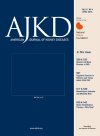Primary Hyperoxaluria: A Need for New Perspectives in an Era of New Therapies
Primary hyperoxaluria (PH) is a rare metabolic anomaly inherited in an autosomal recessive fashion that manifests devastating clinical consequences. Its most common form, PH type 1 (PH1), stems from variants in the AGXT gene that lead to reduced enzymatic activity of alanine glyoxylate aminotransferase (AGT) in the hepatocyte peroxisome.1 Consequently, large amounts of oxalate are generated, which often causes recurrent episodes of nephrolithiasis. Eventually, hyperoxaluria causes more profound kidney injury that progresses to kidney failure and deposition of oxalate systemically, most notably in the skeleton, heart, skin, and retina.



